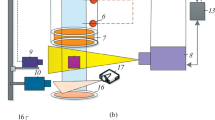Abstract
This paper examines the effects of the mixing of dry air into a cloud top from the point of view of the droplet spectra. It is shown theoretically that the resulting cycling of the air up and down in the cloud, as seems to be the essential mechanism by which cumuli have been diluted to their observed liquid water mixing ratio, can double the largest drop radius and generate cloud parcels containing drops of all sizes up to this maximum. These changes in the droplet distribution with size occur by a process which is not greatly influenced by the cloud condensation nuclei or the details of droplet growth since ‘maritime’ like spectra can develop in ‘continental’ type cumuli. It shows that large numbers of cloud condensation nuclei should not have much effect in inhibiting the rainforming process by reducing coalescence growth. On the contrary, the controlling parameters which determine precipitation efficiency and times seem to be those which control the mixing.
Similar content being viewed by others
References
Carstens, J. C. (1973),Current meteorological theory of the condensational growth of a stationary drop. Tech. Report, Graduate Center for Cloud Physics Research, University of Missouri-Rolla.
Dingle, A. N. andHarding, D. D. (1976),Droplet size development in warm cumulus clouds, Preprints, International Conf. on Cloud Physics, July 26–30, Boulder, Colorado, 33–36.
Fletcher, N. H. (1966),The Physics of Rainclouds. Cambridge Univ. Press. 390 pp.
Fukuta, N. andWalter, L. A. (1970),Kinetics of hydrometeor growth from a vapor-spherical model, J. Atmos. Sci.27, 1160–1172.
Howell, W. E. (1949),The growth of cloud drops in uniformly cooled air, J. Meteorol.6, 134–149.
Latham, J. andReed, R. L. (1977),Laboratory studies of the effects of mixing on the evolution of cloud droplet spectra, Quart. J. Roy. Meteorol. Soc.103, 297–306.
Lee, In-Young andPruppacher, R. H. (1977),A comparative study on the growth of cloud droplets by condensation using an air parcel model with and without entrainment, Pure Appl. Geophys.115, 523–545.
Mason, B. J., andChien, C. W. (1962),Cloud-droplet growth by condensation in cumulus. Quart. J. Roy. Meteorol. Soc.88, 136–142.
Mordy, W. (1959),Computations of the growth by condensation of a population of cloud droplets, Tellus11, 16–44.
Paluch, I. R. (1978),Entrainment in some Colorado multicell storms. Preprints Conf. on cloud physics and atmospheric electricity, July 31–Aug. 4, Issaquah, Wash., 377–383.
Squires, P. (1952a),The growth of cloud drops by condensation. I. General Characteristics, Australian J. Sci. Res.,Series A, 59–86.
Squires, P. (1952b),The growth of cloud drops by condensation. II. The formation of large cloud drops. Australian J. Sci. Res.,Series A, 473–499.
Squires, P. (1958),Penetrative downdraughts in cumuli, Tellus10, 381–389.
Telford, J. W. (1955),A new aspect of coalescence theory, J. Meteorol.12, 436–444.
Telford, J. W. (1975),Turbulence, entrainment, and mixing in cloud dynamics, Pure Appl. Geophys.113, 1067–1084.
Telford, J. W. andWagner, P. B. (1979a),The dynamical and liquid water structure of the small cumulus as determined from its environment, Pure Appl. Geophys., submitted for publication.
Telford, J. W. andWagner, P. B. (1979b),Electric charge separation in severe storms, Pure Appl. Geophys. (in press).
Twomey, S. (1959),The nuclei of natural cloud formation, II. The supersaturation in natural clouds and the variation of cloud droplet concentration, Pure Appl. Geophys.43, 243–249.
Warner, J. (1968),A reduction in rainfall associated with smoke from sugar-cane fires — an inadvertent weather modification, J. Appl. Meteorol.7, 247–251.
Warner, J. (1969a),The microstructure of cumulus cloud. Part I. General features of the droplet spectrum, J. Atmos. Sci.26, 1049–1059.
Warner, J. (1969b),The microstructure of cumulus clouds. Part II. The effect on droplet size distribution of the cloud nucleus spectrum and updraft velocity, J. Atmos. Sci.26, 1272–1282.
Warner, J. (1971),Smoke from sugar-cane fires and rainfall, Proceedings, International Conf. on Weather Modification, Sept. 6–11, Canberra, Australia, 191–192.
Warner, J. (1973),The microstructure of cumulus cloud: Part IV; The effect on the droplet spectrum of mixing between cloud and environment, J. Atmos. Sci.30, 256–261.
Young, K. C. (1975),The evolution of drop spectra due to condensation, coalescence and breakup, J. Atmos. Sci.32, 965–973.
Author information
Authors and Affiliations
Rights and permissions
About this article
Cite this article
Telford, J.W., Chai, S.K. A new aspect of condensation theory. PAGEOPH 118, 720–742 (1980). https://doi.org/10.1007/BF01593025
Received:
Issue Date:
DOI: https://doi.org/10.1007/BF01593025




